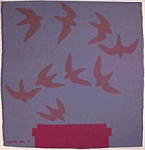| Birds |
||||||
| Signs of injury or ill
health in an adult bird are easy to discern. In some cases you will see
the injury occur. A bird flies into a window, gets clipped by a car, gets
tangled in loose cord, or is attacked by a pet. In such cases, where the
animal has wounds,shows difficulty flying or walking, or cannot move at
all, your best bet is to follow FWC's general emergency
instructions and get the animal to our center as soon as possible. On the other hand, well intentioned people often "rescue" perfectly healthy young birds assuming that, if they are sitting on the ground or moving awkwardly, they must be injured or abandoned. Baby birds spend time on the ground when they are learning to fly. It is therefore very important to determine whether or not the bird you have found is legitimately injured or orphaned. Removing a healthy animal from its parents and siblings does far more harm than good. When you find a baby bird, ask yourself the following questions before deciding to intervene. Was there a storm with high winds? Could the bird have been blown or fallen from the nest? If the baby bird is alert, fully feathered, and hopping around, it has probably reached that age when it is practicing its flying and foraging skills. The parents are still protecting and feeding them at this stage, which only lasts 2-3 days. You can facilitate this process by keeping cats and dogs inside or in a closed yard. Note the bird's location and check on it every three hours or so for about 24 hours. At the end of this period, unless it is injured, it will have joined its parents or moved to another location. If the baby bird has no feathers or cannot stand or perch, it must be returned to the nest. This can usually be located in a tree or shrub very close to where you find the bird. Human scent does NOT cause adult animals to abandon their young as the old wives' tale says. Abandonment occurs when the parent bird loses visual contact with the baby for a period of time which varies for different species. If you stand in the area waiting for the parents to return to the nest, you will keep them from their job and from maintaining their young. It is extremely important that you return the baby to its nest and exit the immediate vicinity as soon as possible. |
|
|||||

